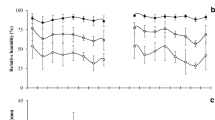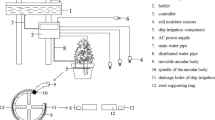Abstract
Modelling studies predicted that climate change will have strong impacts on the coffee crop, although no information on the effective impact of elevated CO2 on this plant exists. Here, we aim at providing a first glimpse on the effect of the combined impact of enhanced [CO2] and high temperature on the leaf mineral content and balance on this important tropical crop. Potted plants from two genotypes of Coffea arabica (cv. Icatu and IPR 108) and one from C. canephora (cv. Conilon Clone 153) were grown under 380 or 700 μL CO2 L−1 air, for 1 year, after which were exposed to an stepwise increase in temperature from 25/20 °C (day/night) up to 42/34 °C, over 8 weeks. Leaf macro − (N, P, K, Ca, Mg, S) and micronutrients (B, Cu, Fe, Mn, Zn) concentrations were analyzed at 25/20 °C (control), 31/25 °C, 37/30 °C and 42/34 °C. At the control temperature, the 700 μL L−1 grown plants showed a moderate dilution effect (between 7 % and 25 %) in CL 153 (for N, Mg, Ca, Fe) and Icatu (for N, K and Fe), but not in IPR 108 (except for Fe) when compared to the 380 μL L−1 plants. For temperatures higher than control most nutrients tended to increase, frequently presenting maximal contents at 42/34 °C (or 37/30 °C), although the relation between [CO2] treatments did not appreciably change. Such increases offset the few dilution effects observed under high growth [CO2] at 25/20 °C. No clear species responses were found considering [CO2] and temperature impacts, although IPR 108 seemed less sensitive to [CO2]. Despite the changes promoted by [CO2] and heat, the large majority of mineral ratios were kept within a range considered adequate, suggesting that this plant can maintain mineral balances in a context of climate changes and global warming.
Similar content being viewed by others
Abbreviations
- Amax :
-
Photosynthetic capacity
- Pn :
-
Net photosynthetic rate
- PSII:
-
Photosystem II
- RuBisCO:
-
Ribulose-1,5-bisphosphate carboxylase/oxygenase
- WUE:
-
Water use efficiency.
References
Ainsworth EA, Rogers A (2007) The response of photosynthesis and stomatal conductance to rising [CO2]: mechanisms and environmental interactions. Plant Cell Environ 30:258–270
Amaral JAT, Rena AB, Amaral JFT (2006) Crescimento vegetativo sazonal do cafeeiro e sua relação com fotoperíodo, frutificação, resistência estomática e fotossíntese. Pesq Agrop Bras 41:377–384
Assad ED, Pinto HS, Zullo J Jr, Ávila AMH (2004) Impacto das mudanças climáticas no zoneamento agroclimático do café no Brasil. Pesq Agrop Bras 39:1057–1064
Bataglia OC, Furlani AMC, Teixeira JPF, Furlani PR, Gallo J (1983) Métodos de Análise Química de Plantas. Boletim Técnico Instituto Agronômico Campinas 78, 48 p
Batista-Santos P, Lidon FC, Fortunato A, Leitão AE, Lopes E, Partelli F, Ribeiro AI, Ramalho JC (2011) The impact of cold on photosynthesis in genotypes of Coffea spp.—Photosystem sensitivity, photoprotective mechanisms and gene expression. J Plant Physiol 168:792–806
Blank RR, Morgan T, Ziska LH, White RH (2011) Effect of atmospheric CO2 levels on nutrients in cheatgrass tissue. Nat Resour Environ Issues 16:1–6
Bragança SM, Martinez HHP, Leite HG, Santos LP, Sediyama CS, Venegas VHA, Lani JA (2008) Accumulation of macronutrients for the conilon coffee tree. J Plant Nutr 31:103–120
Bragança SM, Prezotti LC, Lani JA (2007) Nutrição do cafeeiro Comilon. In: Ferrão RG, Fonseca AF, Bragança SM, Ferrão MA, Muner LH (eds) Café Conilon. DCM/Incaper, Vitória, E.S., Brazil, pp 297–327
Camargo AP (1985) Florescimento e frutificação de café Arábica nas diferentes regiões cafeeiras do Brasil. Pesq Agrop Bras 20:831–839
Camargo MBP (2010) The impact of climatic variability and climate change on arabic coffee crop in Brazil. Bragantia 69:239–247
Carelli MLC, Fahl JI, Ramalho JDC (2006) Aspects of nitrogen metabolism in coffee plants. Braz J Plant Physiol 18:9–21
Ceulemans R, Mousseau M (1994) Effects of elevated atmospheric woody plants. New Phytol 127:425–446
Chen HH, Shen ZY, Li PH (1982) Adaptability of crop plants to high temperatures stress. Crop Sci 22:719–725
Conroy J, Hocking P (1993) Nitrogen nutrition of C3 plants at elevated atmospheric CO2 concentrations. Physiol Plant 89:570–576
Cotrufo MF, Ineson P, Scott A (1998) Elevated CO2 reduces the nitrogen concentration of plant tissues. Glob Chang Biol 4:43–54
DaMatta FM, Ramalho JDC (2006) Impacts of drought and temperature stress on coffee physiology and production: A review. Braz J Plant Physiol 18:55–81
DaMatta FM, Ronchi CP, Maestri M, Barros RS (2007) Ecophysiology of coffee growth and production. Braz J Plant Physiol 19:485–510
Davis AP, Gole TW, Baena S, Moat J (2012) The impact of climate change on indigenous arabica coffee (Coffea arabica): Predicting future trends and identifying priorities. PLoS One 7(11):e47981
EMBRAPA-Empresa Brasileira De Pesquisa Agropecuária (1997) Manual de métodos de análises de solo. 2nd Ed., Ministério da Agricultura e do Abastecimento, Rio de Janeiro, Brazil, 212 p
Fangmeier A, Grüters U, Högy P, Vermehren B, Jäger HJ (1997) Effects of elevated CO2, nitrogen supply, and tropospheric ozone on spring wheat—II. Nutrients (N, P, K, S, Ca, Mg, Fe, Mn, Zn). Environ Pollut 96:43–59
Fortunato A, Lidon FC, Batista-Santos P, Leitão AE, Pais IP, Ribeiro AI, Ramalho JC (2010) Biochemical and molecular characterization of the antioxidative system of Coffea sp. under cold conditions in genotypes with contrasting tolerance. J Plant Physiol 167:333–342
Gay C, Estrada F, Conde C, Eakin H, Villers L (2006) Potential impacts of climate change on agriculture: a case of study of coffee production in Veracruz, Mexico. Clim Change 79:259–288
Guimarães PTG, Reis THP (2010) Nutrição e adubação do cafeeiro. In: Reis PR, Cunha RL (eds) Café Arábica—Do Plantio à Colheita. EPAMIG, Lavras, M.G., Brazil, pp 343–414
IPCC. Climate change (2007) The physical science basis: summary for policymakers. Geneva: IPCC, 2007. 18p. Available in: <http://www.ipcc.ch/SPM2feb07.pdf>. Access: 12 Feb. 2013.
Kirschbaum MUF (2011) Does enhanced photosynthesis enhance growth? Lessons learned from CO2 enrichment studies. Plant Physiol 155:117–124
Lambers H, Chapin FS III, Pons JL (2008) Plant Physiological Ecology, 2nd edn. Springer, New York, 604 p
Leakey ADB, Ainsworth EA, Bernacchi CJ, Rogers A, Long SP, Ort DR (2009) Elevated CO2 effects on plant carbon, nitrogen, and water relations: six important lessons from FACE. J Exp Bot 60:2859–2876
Long SP (1991) Modification of the response of photosynthetic productivity to rising temperature by atmospheric CO2 concentrations: Has its importance been underestimated? Plant Cell Environ 14:729–739
Long SP, Ainsworth EA, Rogers A, Ort DR (2004) Rising atmospheric carbon dioxide: plants FACE the future. Annu Rev Plant Biol 55:591–628
Luo Y, Reynolds J, Wang Y, Wolfe D (1999) A search for predictive understanding of plant responses to elevated [CO2]. Glob Chang Biol 5:143–156
Malavolta E (1993) Nutrição Mineral e Adubação do Cafeeiro. Colheitas Econômicas Máximas. Editora Agronômica Ceres, Ltda., São Paulo, Brazil, 210 p.
Manderscheid R, Bender J, Jäger H-J, Weigel HJ (1995) Effects of season long CO2 enrichment on cereals. II. Nutrient concentrations and grain quality. Agric Ecosyst Environ 54:175–185
Overdieck D (1993) Elevated CO2 and the mineral content of herbaceous and woody plants. Veg 104:403–411
Partelli FL, Batista-Santos P, Campos PS, Pais IP, Quartin VL, Vieira HD, Ramalho JC (2011) Characterization of the main lipid components of chloroplast membranes and cold induced changes in Coffea sp. Environ Exp Bot 74:194–204
Pastenes C, Horton P (1996) Effect of high temperature on photosynthesis in beans. II. CO2 assimilation and metabolite contents. Plant Physiol 112:1253–1260
Penuelas J, Matamala R (1993) Variations in the mineral composition of herbarium plant species collected during the last three centuries. J Exp Bot 44:1523–1525
Polley HW (2002) Implications of atmospheric and climate change for crop yield. Crop Sci 42:131–140
Ramalho JC, Campos PS, Quartin VL, Silva MJ, Nunes MA (1999) High irradiance impairments on photosynthetic electron transport, ribulose-1,5-bisphosphate carboxilase/oxygenase and N assimilation as a function of N availability in Coffea arabica L. plants. J Plant Physiol 154:319–326
Ramalho JC, Campos PS, Teixeira M, Nunes MA (1998) Nitrogen dependent changes in antioxidant systems and in fatty acid composition of chloroplast membranes from Coffea arabica L. plants submitted to high irradiance. Plant Sci 135:115–124
Ramalho JC, Fortunato AS, Goulao LF, Lidon FC (2013a) Cold-induced changes in mineral content in Coffea spp. leaves—Identification of descriptors for tolerance assessment. Biol Plant 57:495–506
Ramalho JC, Pons T, Groeneveld H, Azinheira HG, Nunes MA (2000) Photosynthetic acclimation to high light conditions in mature leaves of Coffea arabica L.: role of xanthophylls, quenching mechanisms and nitrogen nutrition. Aust J Plant Physiol 27:43–51
Ramalho JC, Rebelo MC, Santos ME, Antunes ML, Nunes MA (1995) Effects of calcium deficiency on Coffea arabica. Nutrient changes and correlation of calcium levels with some photosynthetic parameters. Plant and Soil 172:87–96
Ramalho JC, Rodrigues AP, Semedo JN, Pais I, Martins LD, Simões-Costa MC, Leitão AE, Fortunato AS, Batista-Santos P, Palos I, Tomaz MA, Scotti-Campos P, Lidon FC, DaMatta FM (2013b) Sustained photosynthetic performance of Coffea spp. under long-term enhanced [CO2]. PLoS One 8:e82712
Roberntz P, Linder S (1999) Effects of long-term CO2 enrichment and nutrient availability in Norway spruce. II. Foliar chemistry. Trees 14:17–27
Sage RF (1994) Acclimation of photosynthesis to increasing atmospheric CO2: The gas exchange perspective. Photosynth Res 39:351–368
Scotti-Campos P, Pais IP, Partelli FL, Batista-Santos P, Ramalho JC (2014) Phospholipids profile in chloroplasts of Coffea spp. genotypes differing in cold acclimation ability. J Plant Physiol 171:243–249
Silva EA, DaMatta FM, Ducatti C, Regazzi AJ, Barros RS (2004) Seasonal changes in vegetative growth and photosynthesis of Arabica coffee trees. Field Crop Res 89:349–357
Taub DR, Wang X (2008) Why are nitrogen concentrations in plant tissues lower under elevated CO2? A critical examination of the hypotheses. J Integr Plant Biol 50:65–74
Teixeira AL, Souza FF, Pereira AA, Oliveira ACB, Rocha RB (2013) Performance of arabica coffee cultivars under high temperature conditions. Afr J Agric Res 8:4402–4407
Thiec DL, Dixon M, Loosveldt P, Garrec JP (1995) Seasonal and annual variations of phosphorus, calcium, potassium and manganese contents In different cross-sections of Picea abies (L.) Karst. needles and Quercus rubra L. leaves exposed to elevated CO2. Trees 10:55–62
Vogel AI (1961) A Text-Book of Quantitative Inorganic Analysis—Including Elementary Instrumental Analysis, 3rd edn. Longman Group Limited, London
Waraich EA, Ahmad R, Halim A, Aziz T (2012) Alleviation of temperature stress by nutrient management in crop plants: A review. J Soil Sci Plant Nutr 12:221–244
Zhu C, Ziska L, Zhu J, Zeng Q, Xie Z, Tang H, Jia X, Hasegawa T (2012) The temporal and species dynamics of photosynthetic acclimation in flag leaves of rice (Oryza sativa) and wheat (Triticum aestivum) under elevated carbon dioxide. Physiol Plant 145:395–405
Acknowledgments
The authors thank Drs. L.C. Fazuolli (IAC), T. Sera (IAPAR) and F. Partelli (UFES) for supplying the plant material, and Isabel M. Palos (IICT) for technical help. This work was supported by Portuguese national funds through Fundação para a Ciência e Tecnologia, under the scope of the project PTDC/AGR-PRO/3,386/2012 and the grants PDSE 12,226/12–2 (L.D. Martins) financed by CAPES, Brazil. Fellowships granted by CNPq and Fapemig to F.M. DaMatta are also greatly acknowledged.
Author information
Authors and Affiliations
Corresponding author
Rights and permissions
About this article
Cite this article
Martins, L.D., Tomaz, M.A., Lidon, F.C. et al. Combined effects of elevated [CO2] and high temperature on leaf mineral balance in Coffea spp. plants. Climatic Change 126, 365–379 (2014). https://doi.org/10.1007/s10584-014-1236-7
Received:
Accepted:
Published:
Issue Date:
DOI: https://doi.org/10.1007/s10584-014-1236-7




